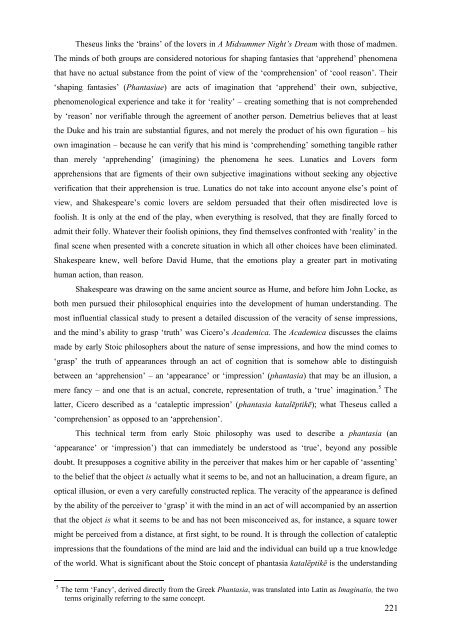Contents - ResearchSpace@Auckland - The University of Auckland
Contents - ResearchSpace@Auckland - The University of Auckland
Contents - ResearchSpace@Auckland - The University of Auckland
Create successful ePaper yourself
Turn your PDF publications into a flip-book with our unique Google optimized e-Paper software.
<strong>The</strong>seus links the ‘brains’ <strong>of</strong> the lovers in A Midsummer Night’s Dream with those <strong>of</strong> madmen.<strong>The</strong> minds <strong>of</strong> both groups are considered notorious for shaping fantasies that ‘apprehend’ phenomenathat have no actual substance from the point <strong>of</strong> view <strong>of</strong> the ‘comprehension’ <strong>of</strong> ‘cool reason’. <strong>The</strong>ir‘shaping fantasies’ (Phantasiae) are acts <strong>of</strong> imagination that ‘apprehend’ their own, subjective,phenomenological experience and take it for ‘reality’ – creating something that is not comprehendedby ‘reason’ nor verifiable through the agreement <strong>of</strong> another person. Demetrius believes that at leastthe Duke and his train are substantial figures, and not merely the product <strong>of</strong> his own figuration – hisown imagination – because he can verify that his mind is ‘comprehending’ something tangible ratherthan merely ‘apprehending’ (imagining) the phenomena he sees. Lunatics and Lovers formapprehensions that are figments <strong>of</strong> their own subjective imaginations without seeking any objectiveverification that their apprehension is true. Lunatics do not take into account anyone else’s point <strong>of</strong>view, and Shakespeare’s comic lovers are seldom persuaded that their <strong>of</strong>ten misdirected love isfoolish. It is only at the end <strong>of</strong> the play, when everything is resolved, that they are finally forced toadmit their folly. Whatever their foolish opinions, they find themselves confronted with ‘reality’ in thefinal scene when presented with a concrete situation in which all other choices have been eliminated.Shakespeare knew, well before David Hume, that the emotions play a greater part in motivatinghuman action, than reason.Shakespeare was drawing on the same ancient source as Hume, and before him John Locke, asboth men pursued their philosophical enquiries into the development <strong>of</strong> human understanding. <strong>The</strong>most influential classical study to present a detailed discussion <strong>of</strong> the veracity <strong>of</strong> sense impressions,and the mind’s ability to grasp ‘truth’ was Cicero’s Academica. <strong>The</strong> Academica discusses the claimsmade by early Stoic philosophers about the nature <strong>of</strong> sense impressions, and how the mind comes to‘grasp’ the truth <strong>of</strong> appearances through an act <strong>of</strong> cognition that is somehow able to distinguishbetween an ‘apprehension’ – an ‘appearance’ or ‘impression’ (phantasia) that may be an illusion, amere fancy – and one that is an actual, concrete, representation <strong>of</strong> truth, a ‘true’ imagination. 5 <strong>The</strong>latter, Cicero described as a ‘cataleptic impression’ (phantasia katalēptikē); what <strong>The</strong>seus called a‘comprehension’ as opposed to an ‘apprehension’.This technical term from early Stoic philosophy was used to describe a phantasia (an‘appearance’ or ‘impression’) that can immediately be understood as ‘true’, beyond any possibledoubt. It presupposes a cognitive ability in the perceiver that makes him or her capable <strong>of</strong> ‘assenting’to the belief that the object is actually what it seems to be, and not an hallucination, a dream figure, anoptical illusion, or even a very carefully constructed replica. <strong>The</strong> veracity <strong>of</strong> the appearance is definedby the ability <strong>of</strong> the perceiver to ‘grasp’ it with the mind in an act <strong>of</strong> will accompanied by an assertionthat the object is what it seems to be and has not been misconceived as, for instance, a square towermight be perceived from a distance, at first sight, to be round. It is through the collection <strong>of</strong> catalepticimpressions that the foundations <strong>of</strong> the mind are laid and the individual can build up a true knowledge<strong>of</strong> the world. What is significant about the Stoic concept <strong>of</strong> phantasia katalēptikē is the understanding5 <strong>The</strong> term ‘Fancy’, derived directly from the Greek Phantasia, was translated into Latin as Imaginatio, the twoterms originally referring to the same concept.221














